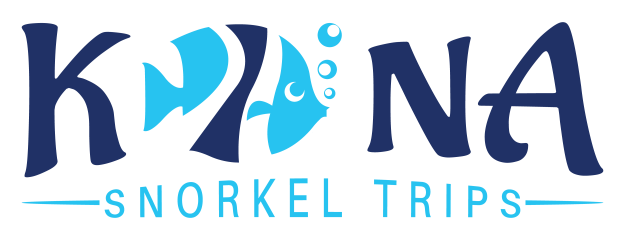Best Whale Watching Tours Kona Hawaii – Book Your Adventure Today
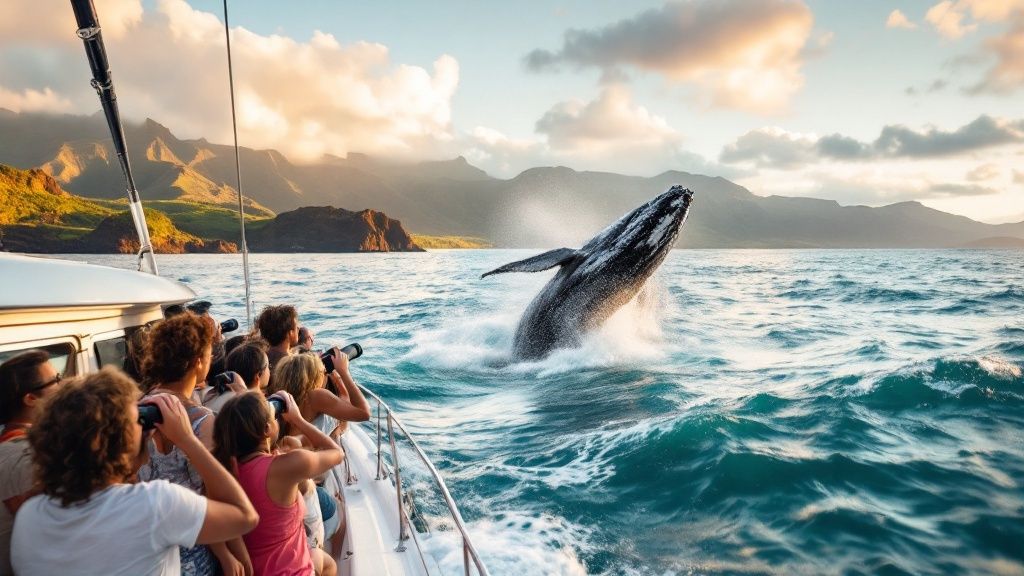
If you're looking for the best whale watching tours Kona has to offer, the magic really happens between December and March. This is when the annual humpback whale migration is in full swing, giving you a front-row seat to one of nature's greatest shows. And for my money, the best way to experience it is with a top-rated crew like Kona Snorkel Trips—they're the top rated & most reviewed snorkel company in Hawaii for a reason.
Welcome to Kona's Breathtaking Whale Season
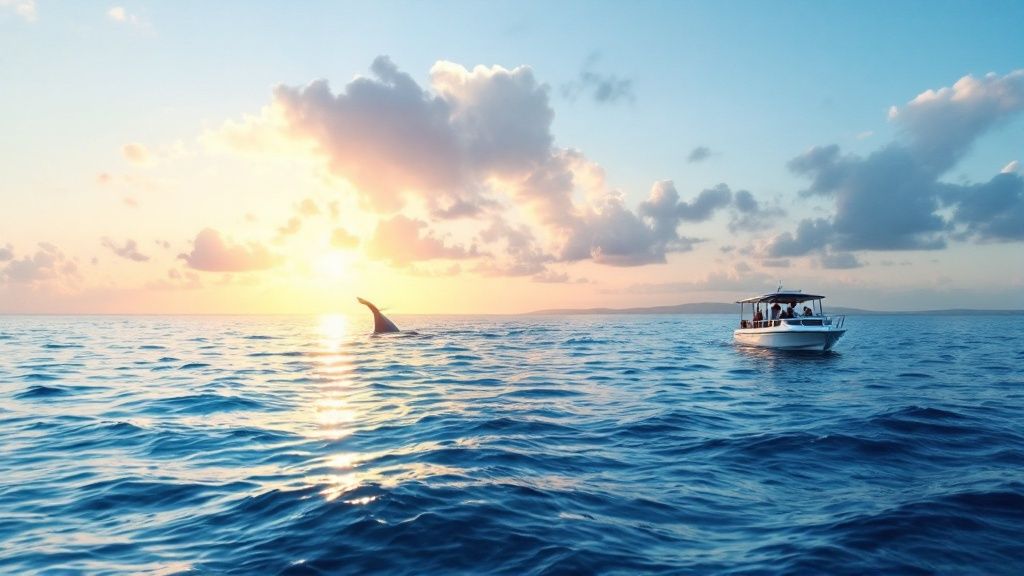
Every winter, something incredible happens. The calm, protected waters off the Kona coast completely transform. They become a sanctuary for thousands of humpback whales making an epic 3,000-mile journey from the frigid feeding grounds of Alaska. They come here to our warm Hawaiian seas to breed, give birth, and care for their newborn calves.
This spectacular migration easily makes Kona a world-class destination for seeing these gentle giants.
The Big Island's unique geography plays a huge part. Our massive volcanoes shield the coastline from the harsher trade winds, creating the perfect, tranquil nursery. These calm conditions don't just attract the whales; they also make for a much more comfortable and clear viewing experience when you're out on a whale watching tour in Kona, Hawaii.
A Journey of Epic Proportions
The annual migration is a massive undertaking, and the first sightings each winter signal the start of months of non-stop action. This yearly event draws people from all over the world, all hoping to get a glimpse of the roughly 10,000 humpback whales that pass through Hawaiian waters. You can always check out recent reports to see when the season is officially kicking off.
An adventure on the water here is so much more than just sightseeing—it's a floating classroom. The onboard naturalists I've worked with are fantastic, sharing incredible insights into whale biology and behavior. It turns a fun trip into a real connection with the ocean's wonders.
Out on the water, you can expect to see some truly mind-blowing displays:
- Breaching: There's nothing like seeing a 40-ton animal launch its entire body out of the water. It’s pure power.
- Tail Slapping: You'll hear the powerful smack of a fluke on the ocean surface long before you see it.
- Spy-Hopping: This is when a curious whale pops its head straight out of the water to get a better look around. It feels like they're checking you out!
- Mother-Calf Pods: Watching the tender moments between a mother and her newborn is something you'll never forget.
This guide will walk you through everything you need to know to plan the perfect whale watching adventure. My goal is to help you make the most of this truly magical season.
Pinpointing the Best Time for Whale Watching in Kona
Timing is everything if you want to witness the jaw-dropping spectacle of humpback whales in Kona. While our ocean is stunning any day of the year, scheduling your tour during peak season can be the difference between a good trip and an absolutely incredible one, filled with multiple, up-close encounters.
The official whale watching season here in Kona runs from December through March. This is the magic window when thousands of humpback whales finish their epic migration from the chilly waters of Alaska to Hawaii's warm, protected seas. They make this incredible journey for one reason: to breed and give birth to their calves in a safe environment.
The Peak of the Action
Now, while that whole four-month stretch is great, if you're looking for the absolute sweet spot, it's January and February. Hands down.
During these two months, the sheer density of whales off the Kona coast is at its highest. It feels like the ocean just comes alive. You'll see males competing for mates in powerful displays and new mothers patiently teaching their calves the ropes of being a whale. Booking your whale watching tour in Kona, Hawaii during this peak ensures you have the best possible odds for a truly unforgettable day on the water.
The difference is staggering. In these prime months, it’s not unusual for our friends along the Kohala Coast to spot three, four, even six whales in a single 15-minute span! Less time searching means more time watching these magnificent animals do their thing.
Why Morning Tours Are a Top Choice
Beyond just picking the right month, the time of day you head out can make a huge difference in your experience. We almost always recommend early morning tours, and for a couple of really good reasons.
First off, the ocean conditions are typically just pristine in the morning. Before the afternoon trade winds kick in, the water is often glassy and smooth. That makes for a much more comfortable ride and way better viewing.
But here’s the real insider tip: the whales themselves are often way more active in the morning. Research has shown that whale activity can be roughly 50% higher at 8:00 a.m. than it is around midday. That translates to more chances to see those spectacular breaches, powerful tail slaps, and all the fascinating social behaviors that make these encounters so special.
If you really want to get into the nitty-gritty of what makes this time of year so special, we've got a whole post breaking down the Big Island whale season in our detailed guide.
So, to recap: booking your tour between January and February, and grabbing a spot on a morning departure, is the perfect recipe for a magical whale watching adventure here in Kona. It puts you on the water when the conditions are best and the whales are at their most dynamic.
To help you visualize the season, we've put together a simple chart outlining what to expect month by month.
Kona Whale Watching Season At a Glance
This table gives you a quick summary of whale activity levels throughout the season, helping you plan the perfect time for your trip.
| Month | Whale Activity Level | Typical Sighting Frequency |
|---|---|---|
| December | Good | Whales are arriving; sightings are consistent but less dense. |
| January | Excellent (Peak) | High density of whales; frequent sightings of active pods. |
| February | Excellent (Peak) | The absolute highest concentration of whales; best time for action. |
| March | Good | Whales begin their migration back north; mothers and calves often seen. |
Ultimately, planning around this peak season gives you the best shot at seeing exactly why we get so excited when the whales return to Kona each year.
How to Choose Your Perfect Kona Whale Tour
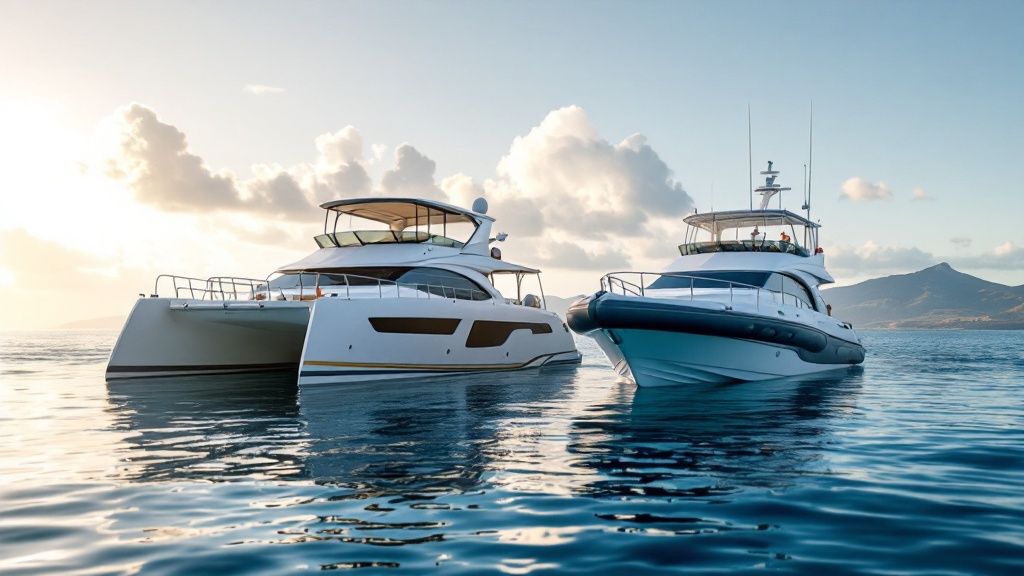
Picking the right whale watching tours Kona Hawaii has on offer is the secret to an unforgettable day on the water. You've got options, and your perfect trip really comes down to what you're looking for—comfort, adventure, or something in between. Your main choice will be between a big, stable catamaran and a smaller, zippy raft.
Each boat delivers a totally different kind of adventure. Think of it like choosing between a comfy, scenic bus tour versus a nimble, off-road jeep safari. Both get you there, but the journey itself is worlds apart.
Large Catamarans: The Stable Choice
For a lot of folks, especially families with little kids or anyone who gets a bit queasy on the water, a large catamaran is the way to go. These spacious, double-decker boats give you a smooth and steady ride, even when the ocean gets a little choppy.
Here’s why people love the catamarans:
- More Amenities: You'll almost always find onboard restrooms, plenty of shaded seating, and lots of room to walk around and stretch your legs.
- Comfort: That stability seriously cuts down on the chances of seasickness, so you can focus on the whales instead of your stomach.
- Excellent Views: With multiple viewing decks, you get these great panoramic vantage points for spotting spouts and breaches from way off in the distance.
This is the boat you pick for a relaxed, comfortable experience that’s a real crowd-pleaser for all ages.
Small Rafts: The Intimate Encounter
If you’re craving a more thrilling, up-close-and-personal adventure, then a smaller, agile raft is probably your perfect match. These boats sit low in the water, giving you a unique, eye-level perspective on the whales and any other marine life that pops up.
Because they're so fast and maneuverable, rafts can quickly change position to get you the best possible (and legally compliant) view of the action. It's a much more intimate trip where you feel every ripple and can literally hear the whales breathe.
Just keep in mind, this kind of tour is more exposed to the elements and can be a bumpy ride. It’s definitely best suited for those with a real spirit for adventure.
The Value of a Naturalist-Led Tour
No matter what kind of boat you choose, the single most important factor is the crew. Going with a tour led by an experienced marine naturalist turns a simple sightseeing trip into a fascinating learning experience. These experts share incredible details about whale behaviors, their long migration patterns, and the whole local ecosystem.
Plus, their trained eyes are amazing at spotting whales from far away, which means more time watching whales for you. And with so many whales in our waters, your chances of a great sighting are incredibly high.
During one recent count, volunteers right here on the Big Island spotted 28 humpback whales from just eight different sites in a single day. Statewide, the count hit an impressive 714 whales! It just goes to show you the sheer amount of activity you can expect. You can dig into the latest Hawaii whale count data to get a sense of the scale.
What to Expect During Your Whale Watching Adventure
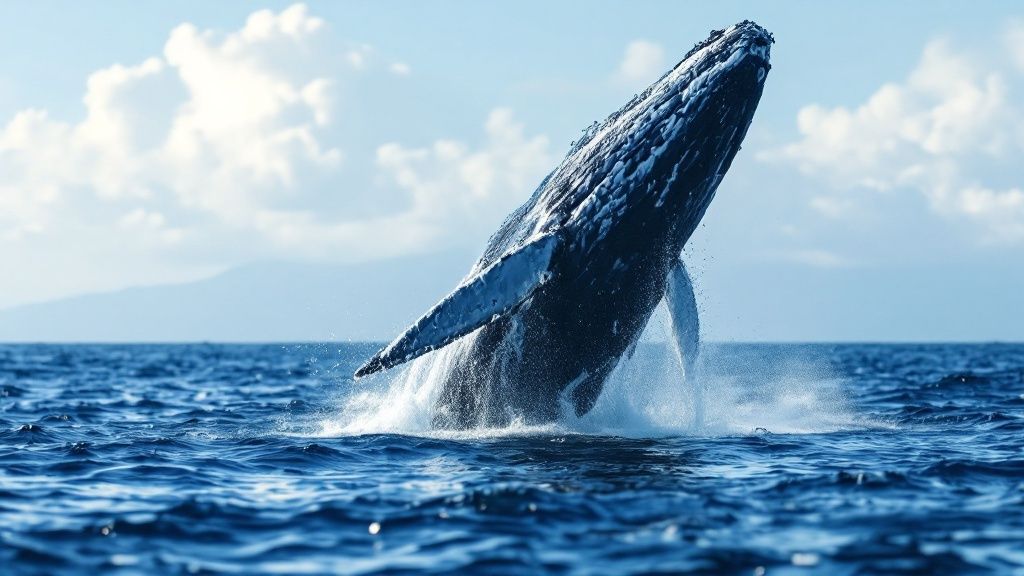
There’s a special kind of energy in the air the moment your tour boat pulls away from the Kailua-Kona pier. You can feel the buzz of anticipation from everyone on board. As the gorgeous Kona coastline starts to shrink behind you, all eyes instinctively turn toward the deep blue of the Pacific, searching the horizon for that first telltale sign of a whale.
Your trip kicks off with a quick safety chat from the crew. These folks aren't just skilled sailors; they’re true marine experts, and their passion for the ocean is contagious. They’ll share some incredible facts about the humpback whales you’re hoping to see, setting the stage perfectly for the encounter ahead. Most whale watching tours Kona Hawaii offers last about 2 to 3 hours, which is plenty of time to get out on the water and find the action.
The Thrill of the First Sighting
Spotting a whale is a team effort, and when it happens, the excitement spreads like wildfire. A crew member might suddenly point and yell, "Spout at 2 o'clock!" and everyone rushes to the side to see that classic misty plume shoot up from the surface. It's the first clue that one of these giants is sharing the water with you.
From there, your captain will expertly guide the boat, always keeping a respectful and legal distance while getting you closer for a better look. This is where the real magic starts, and you could be treated to a whole range of awe-inspiring behaviors.
Incredible Humpback Whale Behaviors
Because these are wild animals in their natural habitat, no two whale watching tours are ever the same. That's part of the fun! But during Kona's peak season, there are a few spectacular displays that people see time and time again.
Keep your eyes peeled for some of these incredible moments:
- Breaching: This is the one everyone hopes for. There’s nothing quite like seeing a 40-ton whale propel its entire body out of the water. It’s a display of raw power that will genuinely leave you speechless.
- Tail Slapping (Lobtailing): You'll often hear this before you see it—the massive crack of a whale’s fluke hitting the water. It’s a powerful sound, thought to be a way of communicating or maybe just showing off.
- Spy-Hopping: This is such a cool, curious move. A whale will pop its head straight up out of the water, almost like it's trying to get a better look at you and the boat. It really feels like they're checking you out!
- Mother and Calf Pairs: There are few things more touching than seeing a massive mother whale gently nudge her newborn calf along. It’s a tender, unforgettable moment that really puts their journey into perspective.
A really special feature on many tours is the onboard hydrophone. Your guide might drop one into the ocean, letting you listen in live to the haunting, complex songs of the male humpback whales. Hearing their calls echoing from the deep is an experience that adds a whole other dimension to the trip.
Throughout the adventure, the naturalists on board will provide a running commentary, explaining what you're seeing and why it's significant. Their insights turn a great sightseeing trip into a fascinating educational experience. Most tours also have some snacks and drinks on hand, so you can stay comfortable and refreshed while you take it all in.
How to Prepare for a Great Day on the Water
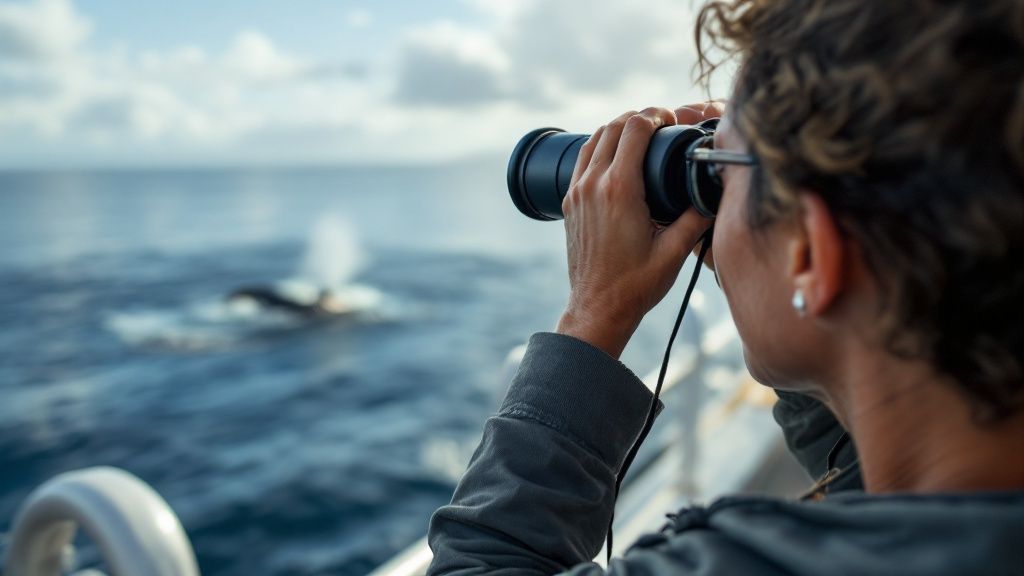
A little bit of prep work before your whale watching tours Kona Hawaii adventure can be the difference between a good day and an absolutely perfect one. When you have the right gear, you’ll be comfortable, protected from the elements, and free to focus on the incredible marine life all around you.
The secret to dressing for a day at sea is all about layering. Kona is famous for its gorgeous weather, but things can change in a hurry once you're out on the water. It can get breezy once you leave the coast, so tossing a light, waterproof jacket or a simple windbreaker over your clothes is always a smart move.
Your Essential Packing Checklist
Packing a small bag with a few key items means you're ready for anything the day throws at you. From sun protection to capturing that perfect photo, here’s a simple checklist to get you started:
- Reef-Safe Sunscreen: The Hawaiian sun is no joke, especially when it’s reflecting off the water. Do your skin—and our fragile coral reefs—a favor by choosing a mineral-based, reef-safe formula.
- Sun Protection Gear: A wide-brimmed hat is non-negotiable for shielding your face and neck. Polarized sunglasses are also a must; they slice right through the glare on the water's surface, making it so much easier to spot the whales.
- Camera with Zoom: You are absolutely going to want to capture those jaw-dropping breaches and tail slaps. A camera with a decent zoom lens lets you get those amazing shots while the boat keeps a respectful distance from the animals.
- Binoculars: While we'll get you close to the action, a good pair of binoculars gives you an even more intimate, front-row seat to whale behaviors and any other marine life we happen to meet.
Staying Comfortable on the Water
Nothing ruins a fantastic day on the ocean quicker than a bout of seasickness. Thankfully, Kona's waters are known for being pretty calm, but it's always wise to be prepared, especially if you know you're prone to motion sickness. A good first step is to eat a light meal beforehand and steer clear of greasy foods.
If you’re particularly sensitive, an over-the-counter medication can be a lifesaver. The trick is to take it proactively—before you even think about stepping onto the boat.
For a deeper dive into more strategies and natural remedies, check out our complete guide on how to prevent seasickness on your boat tour. With these tips in your back pocket, you’ll be ready to soak up every single moment of your whale watching experience.
Understanding Responsible Whale Watching Practices
Seeing a humpback whale arc out of the water is a moment you'll never forget. It's a genuine privilege, and one that comes with a responsibility to keep these giants safe. The best whale watching tours Kona Hawaii offers are all built on a deep respect for the animals, making sure our excitement doesn't interfere with their lives. It's all about being a conscious traveler out on the water.
There are strict federal laws in place for a reason: every boat has to stay at least 100 yards away from humpback whales. This isn't just a suggestion; it's a critical rule, especially here in Hawaii where moms are busy nursing their brand-new calves. Giving them this space is the single most important thing we can do to avoid stressing them out, letting them rest, feed, and migrate peacefully.
More Than Just a Tour
But for the truly reputable operators, following the law is just the starting point. They're woven into the fabric of marine conservation, often partnering with local research groups. Their boats become more than just tour vessels; they're platforms for collecting vital data that helps scientists understand and protect the whales.
This commitment is everything for the long-term health of our oceans. A safe and incredible day for everyone—whales included—means sticking to comprehensive marine life safety guidelines. When you pick a tour company that lives by these principles, you're not just a passenger; you're directly funding the protection of this amazing ecosystem.
Choosing a tour company that puts education and conservation first makes you an active participant in protecting the very creatures you've come to admire. Your ticket isn't just for a boat ride; it helps fund crucial research and conservation that will benefit Hawaii's marine life for generations.
Your Role as a Conscious Traveler
Another huge piece of the puzzle is education. On a great tour, the onboard naturalists do more than just shout, "Whale at 2 o'clock!" They pull you into the whales' world, explaining their behaviors, their incredible migration journey, and the challenges they face. This turns a simple sightseeing trip into something much deeper and more meaningful.
By choosing ethical operators, you're casting a vote with your wallet, showing that these sustainable practices are what travelers want. To get a better sense of why their journey here is so important, you can learn more in our deep dive on the Hawaii whale season. Your choice ensures that people will be able to come here and be awestruck by Kona's gentle giants for many years to come.
A Few More Questions About Kona Whale Watching
Even after planning the perfect trip, a few questions always seem to pop up before heading out on the water. Let's tackle some of the most common ones so you can feel totally prepared for your whale watching tour in Kona.
Is a Whale Sighting Guaranteed on Tours?
This is the big one, isn't it? While Kona’s waters are a major hotspot for humpbacks during peak season, it’s important to remember they are wild animals on their own schedule. Because of this, no one can ever truly make a 100% guarantee.
That being said, experienced crews know exactly where to look and have incredibly high success rates, often over 95% during January and February. Most reputable tour companies offer a "whale guarantee" to give you peace of mind. It usually means that if the whales are shy on your trip, you can come back out for another tour, free of charge. Just be sure to ask about the specific policy when you book.
How Close Can the Boats Get to the Whales?
Federal law is crystal clear on this: all boats have to stay at least 100 yards away from humpback whales. This rule is non-negotiable and it's there to protect the animals, especially new mothers and their incredibly vulnerable calves.
Now, the whales themselves haven't read the rulebook. They are naturally curious and often decide to approach the boats on their own for a closer look. When this happens, it's absolutely magical. A responsible captain will immediately cut the engines and let the whales dictate the encounter, always putting their safety and comfort first.
Are Children Welcome on Whale Watching Tours?
Absolutely! Most Kona whale watching tours are fantastic experiences for the whole family. It's an activity that sparks wonder in kids and adults alike.
If you have younger children, I'd recommend a larger, more stable catamaran. They offer a much smoother ride, give the kids more space to move around, and usually have essential amenities like onboard restrooms. Some of the smaller, zippier raft tours might have age or height restrictions because the ride can get a bit bumpy, so it's always smart to double-check with the company if you're bringing the little ones along.
What Other Marine Life Might I See on a Tour?
While the humpbacks are the main event, the ocean off the Kona coast is practically bursting with life. You’re almost guaranteed to be greeted by a pod of spinner dolphins, famous for launching themselves out of the water in breathtaking acrobatic displays.
But the fun doesn't stop there. Keep your eyes peeled for bottlenose dolphins, spotted dolphins, and even the occasional pilot whale. It’s also common to see Hawaiian green sea turtles (honu) gliding gracefully near the surface. Every trip is different, and you never know what the ocean might reveal.
Ready for an unforgettable ocean adventure? Kona Snorkel Trips offers exceptional, small-group whale watching tours led by expert guides. Book your tour online today and get ready to witness the magic of Kona's gentle giants.
